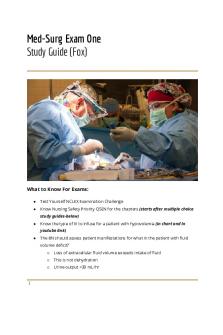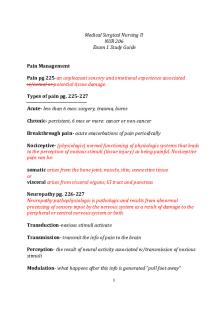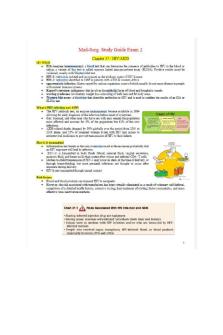Med surg exam 1 study guide PDF

| Title | Med surg exam 1 study guide |
|---|---|
| Author | ro Jean |
| Course | Adult Nursing Practice |
| Institution | Regis College |
| Pages | 25 |
| File Size | 476.3 KB |
| File Type | |
| Total Downloads | 22 |
| Total Views | 135 |
Summary
Download Med surg exam 1 study guide PDF
Description
Exam 1 Study Guide NUR1035 Professional Behavior
Work well with the whole health care team Nursing and Professional Behaviors o Collaboration o Communication o Ethics
Collaboration o Professional behaviors build trust and help prevent conflict by respecting the expertise of other nurses and members of the health team care team. Interdisciplinary teams and communication Conflict resolution Case management Cultural awareness and intergeneration respect
Communication o Reliability and accountability for information and the methods in which it is conveyed using a professional manner at all times to establish trust and rapport with pt, family members, and members of the health care team Assertive not aggressive Passive- always agree, talks little Assertive- firm but polite and clear messages, respectful of self and others Aggressive- critical, know it all, don’t care what others want/ think Take into consideration how the patient feels Therapeutic Communication Electronic communication Netiquette- acceptable way of communicating over the internet Be careful what you say and how you say it o Accurate and complete documentation and reporting to assure client safety at all times Ethics o Professional Behaviors support nurse in maintain an ethical nursing practice by understanding and following standards for professional nurses Code of Ethics- ANA (American Nurses Association) o Ensures that patients’ rights are respected in all healthcare settings o Outlines the important general values, duties, and responsibilities that flow from the specific role of being a nurse o Guides our practice, nursing guidelines o Standard of care Ethical Principles o Autonomy
o o o o o
o o o o
Promote self-determination and freedom of choice Beneficence Actions are taken in effort to promote good (always do good) Nonmaleficence Actions are taken in an effort to avoid harm Paternalism One individual assumes the right to makes decisions for another Utility The good of the many outweighs the wants or needs of the individual Justice Seek fairness treat “equals” equally; and treat “unequal” according to their differences Veracity Obligation to tell the truth (no sugar coating) Fidelity Need to keep promises Confidentiality Keep privileged information private Look at the code of ethics
Disruptive Interpersonal Behavior o Incivility Any action that is offensive, intimidating, or hostile that interferes with the learning and practice environment. Such behavior may be increasing, thus jeopardizing the welfare of the educational and /or practice setting of nurses o Bullying Horizontal Violence Aggressive behavior toward one nurse or a group of nurses Including bullying, acts of unkindness, gossip, intimidation, withholding of information, ect. Persistent acts of disrespect Nursing Bulling Negative communication between nurse and physician o Organizational response to disruptive behaviors
Managing Care Managed Care-Is healthcare delivery system that focus on decreasing the cost and improving the outcomes for groups of PT Case Management -is the coordination of pt care over time using the combination of health and social services necessary to meet the individual patient’s needs. Case management is a fundamental element of many managed care systems.
Case management coordinates care
o o o
Nurse or social worker Deal with the insurance companies They oversee everything See what nurses are doing
Managing Care- care coordination and case management are chief components
Care planned from initial contact with the pt through conclusion Goal is to lower costs and have better outcomes Interdisciplinary practice how we mange ppl o Starts at admission (Discharge) o Goes to discharge and even after Nurses always create care plan on admission o Example: patient has PNA Raise the head of the bed Incentive spirometer Check 02 sat, Temp for infection Listen to lung sounds for fluid in lungs Highest priorities o Safety o Maslow Hierarchy Physiologic needs Safety needs Love and belonging needs Self-esteem needs Self-actualization needs
o
ABCDE Airway, breathing, circulation, Disability, Exposure
o
o
o
Low Priority Problems that typically can be resolved easily with minimal interventions. responding to a clients wish for a snack, can be delegated Medium Priority Problems that may result in unhealthy physical or emotional consequences but that are not life threatening client in spiritually distress, request hospital chaplain High Priority Problems includes life threatening problems of airway, breathing, and circulation , or conditions that have a potential to become life threatening within a short amount of time frequent monitoring for unexpected changes in VS and drainage for pt
Delegation
What is delegation? o Transferring of a task and concluding it o Part of safety Nurses can delegate to a CNA o LPNs can delegate a qualified unlicensed person o RN’s responsible for the supervision of patient care tasks delegated Nurses are ultimately responsible CNA’s can do nursing tasks but nurses need to assess o Example: CAN takes blood sugar and gets 46, it’s the nurses responsibility to go recheck it and assess the patient Let the CNA’s know what they should be alert of and why o Example: checking a patients BP who has hypertension
Successful Delegation
Plan ahead o Nursing interventions o Think of what you can delegate out Communicate goals clearly o Need a blood sugar at 7:30, make it clear Respectfully communicate Monitor the role and provide guidance o Check in the with CNA, ask if they need help Evaluate performance o New CNA, watch what they are doing o If teaching them something new have them show it you back
The Delegation Process
Assessment and planning Communication Surveillance and supervision Evaluation and feedback
The Five Rights of Delegation
Right task o The Delegator must ensure that the task is one that can be delegated according to the agency’s polices and procedures and is appropriate for the specific PT Right circumstance o Is the patient stable? o The Delegator must determine the task addresses the PT’s needs and contributes to a desired outcome, and that adequate supervision is available. Right person o The Delegator must assign the task to a delegate who has the necessary skills and experience. Moreover, the task must be within that individual’s scope o CNA? LPN? RN? Right direction/ communication o The Delegator must provide a clear, concise description of the task, along with its objectives, limits, and expectations. This material may be communicated orally or written format. The delegator must also verify that the delegate understands the information that has been communicated Right supervision o The Delegator must monitor and evaluate the delegate’s performance. This includes providing feedback and intervening if necessary o Does the nurse need to be there? o Should the nurse be doing that? Care of an unstable PT should never be delegated to a LPN, LVN, or UAP if RN delegate all or part of the care of an unstable PT to another RN
Delegation Errors
Unnecessary Duplication o If staff are duplicating the work of others, related task may have been given to too many people. To avoid unnecessary duplication, associated task should be delegated to as few people as possible. Under delegation
o
Is a situation in which efforts at delegation fail because of one or more of the following factors : The delegator fails to transfer full authority to the delegate The delegator take back responsibility for certain aspects of a delegated task. The delegator fails to appropriately equip and direct the delegate.
Reverse Delegation o Someone with lower rank delegated a task to someone with more authority.
Over delegating o Occurs when delegator loses control of a situation by providing the delegate with too much authority or too much responsibility Never DELEGATE NURSING PROCESS STEPS o ASSESSMENT o DIAGNOSIS o DEVELOPING THE CARE PLAN o EVALUATING THE CARE PLAN o THEN MODIFING THE CARE PLAN BASED ON EVALUTION Delegation Supervision , and making an assignment o Accountably Answerable to your own actions / practice o Competence Application of knowledge skills and ability for the delivery of safe standards of practice o Systems responsibility Admin. Responsibility to develop the polices and practice , but nurse and delegatee all have some responsibility as part of the system o Goal Oriented Communication o Supervision Oversight for staff: Initial direction Ongoing oversight Follow up and evaluation o Role of Boards of Nursing and Public protection Mission of all boards of nursing and done through laws regarding practice and training of nurse.
What can RN’s, LPN’s and CNA’s do? RN’s Should always take care of ICU patients because of changes in condition
LPN’s Give oral meds, IM injections, and insulin nut can NOT push meds. Can hang IV antibiotics but can’t push through IV
CNA’s
Providing nursing care to a patients with recent history of flash pulmonary edema
Administer a flu shot to a post op patient
Bathing a post op patient in bed
Completing admission assessment for a patient with chronic kidney disease
Administer routine PO meds to a patient with chronic atrial fibrillation
Ambulating a COPD patient in the hallway
Providing nursing care for a patient on cardiac monitoring
Reinforce diabetic education to a newly diagnosed diabetic
Discharge teaching for a newly diagnosed type 2 diabetic
Wet to moist dressing on a chronic venous ulcer
Empty urine from Foley catheter into a 24- hour collection container Documenting a patient belonging into the computer system upon admission
Initiate and IV Morphine drip for a hospice care patient Obtaining a annual BP on a patient with hypertension
Cardiac monitoring is always delegated to RN If it’s a NEW ulcer and admission assessment of wound- delegated to RN Chronic ulcer- LPN Initiate- RN More examples in ATI Fundamentals book on page 44-46
Peri-Operative
Contains pre-op, intra-op, and post-op
*Pre- Operative*
Begins When the client identified as candidate for surgery Assess and prepared for surgery Lab test, medication administration From decision of surgery until OR Nurses goals o Safety Right surgery Right pt Right site
Pre-Op Nursing Care
Assessment (risk of operative complications) o Medical history Cardiovascular Heart attack? Respiratory PNA? Hepatic/ renal Process meds? Endocrine Blood sugar? Immune function Infection? o Cognitive ability Dementia Easier on meds Start at lower doses and increase o Medication use
o
o o
o
o o o
Fluid status and electrolyte imbalance Cardiac issues If electrolytes are too high or too low, heart can stop Nutritional status Dentition Dentures? If so take out before surgery and put in safe spot or give to family Lose teeth? Don’t want to choke Smoking, drug or alcohol use Withdrawal Require higher doses Psychosocial factors Skin impairment Make sure no skin breakdown before putting in OR bed for hours Mobility restrictions
Verifies pre-op diagnostic testing and specific orders o NPO prior to surgery Prevent from aspiration o Surgical site marking (Dr’s signature) o Denture removal o Preparing bowel for GI or rectal surgery May have to drink certain fluids o Preparing skin Antiseptic scrub to decrease microorganisms Prevents infection Clip, don’t shave hair before surgery Prevent cuts o Providing psychosocial support Reduce anxiety, fear Important, but least important with nursing priorities Verification and signed operative consent o Can be signed for pre-op visit a few days before surgery o Must be given freely and if possible, in writing Ex: ICU pt who’s unconscious, can call family over phone to get consent o Pt must understand risks and benefits of surgery o Must know alternative options o Dr must explain everything to the pt Nurse has to witness/verify the pt signature it and can clarify if needed o Only not necessary to obtain consent when: Emergency surgery Unconscious pt who needs surgery o Must be 18 yrs or older o Must be mentally capable Dementia, psych pt, disabled, intoxicated, brain injury
Discuss advanced directive documents o Pts wishes o If stop breathing do you want a tube down your throat to help you? Explains surgical phrases and expectations o You may be confused when you wake up Initiate teaching and discharge planning o Do before pt goes to surgery because awake and alert
Individuals with an increased surgical Risk
Very old, very young Existing cardiac and respiratory disease Malnourished or obese Smokers Immobile at baseline Incision site location Need to think, is it worth having the surgery or no? Will it be worth it? The Dr. has the right to decide if they want to do the surgery or not. If they don’t feel safe then they don’t have to.
Pain Management in the Older Adult
Increase risk for adverse effects due to age related changes Smaller doses are sufficient and minimize side effects o Older adults usually need smaller doses and give more if its needed Assess hepatic and renal function before administering Monitor effects for overmedicating or under medicating Increased likelihood of confusion
Lab Values
Norms or lab values are different everywhere Types of lab values: o Chemistry Panel o Complete Blood count o Coagulation labs How thin or thick your blood is PT PTT INR Increase coags- bleed out
Patient Education
Deep breathing, coughing incentive spirometry o Teach before surgery, when awake o Prevents atelectasis o Prevents PNA o Incentive spirometry: Breath IN and hold When you hold for 5 seconds, expands the alveoli Promotes lung expansion, helps prevent post op PNA 10 breaths/hr while awake Splint or support the incision to promote maximal comfort Mobility o If can move always get up moving ASAP o If bed rest turn and reposition every 2 hrs o Risks: Bed sores Blood clots To prevent use SCD boots o Assist with venous blood return o Trying to prevent blood clots DVT (deep vein thrombosis)
Pre-Op Meds
Benzodiazepines o Lorazepam (Ativan), Midazolam (versed) o Central nervous system depressant o relaxes you, makes you have less anxiety o if giving and then have to go to BR, recommend bed pan/ urinal (shouldn’t be getting up) o watch out for respiratory depression and hypotension may have given too much o always maintain SAFETY Antibiotics o Cefazolin (ancef), Clindamycin, Ampicillin/Sulfabactam o Prevents surgical site infections o Watch out for allergic reaction or anaphylaxis- life threatening allergic reaction o Must be given within one hour prior to surgical incision
Before Sending to the OR, the nurse must:
Patient identification o Name and DOB Review of medical record Right site IV line Administer meds as ordered
o Benzodiazepines? To relax pt Ensure pt comfort o Important but not as important as others Review pre- op checklist
*Intra- Operative*
Time from the OR to the PACU
Members of the surgical team
Patient Circulating nurse o Monitors the surgical team – SAFETY o Gets stuff together o Paper work o Only one not scrubbed down Scrub role o Sterile table o Hands instruments o stitches Surgeon o Does the surgery Anesthesiologist o Administers meds o Monitors VS to make sure pt is stable If you see that something is done wrong, correct the person o Example: someone adds something non sterile to a sterile field then the field is contaminated, correct them. Always be the patient advocate
Surgical Asepsis
Purpose: o Keep free from microorganisms o Prevent infection of surgical wounds Guidelines: o All material must be sterile o Must be constantly maintained and monitored o Prepared as close to time of surgery as possible
Types of Anesthesia
General o Unconscious o Body relaxation o Inhale or IV Regional
Over specific body area Epidural or spinal Giving birth Moderate sedation o Conscious sedation o Reduces anxiety and controls pain o Putting shoulder back in place, colonoscopy Local o Injected into tissue at incision site Cavity Dermatologist (mole removal) o o
Surgical Time Out
Immediately before the start of surgery Involves entire team Includes: o Correct pt o Correct side and site o Agreement of procedure to be done Everyone agrees Happens after given anesthesis
*Post- Operative*
PACU- follow up care
Post- Op Nursing Care
Assess the pt Maintain patent airway o TOP PRIORITY o w/o 02 nothing else is happening o monitor because pt is induced to not breath (anesthesia) then expected to breath Functioning IV Cardiovascular stability o HR, BP stable Assess surgical site and drains Relieve pain and anxiety Control N/V
Post- Op Complications
Atelectasis (collapsing of alveoli) and PNA (bacteria in lungs) can cause hypoxemia (low 02) DVT
o Clots in legs Hemorrhage or hematoma o Excessive bleeding Constipation o Immobile o Pain meds and anesthesia Pulmonary embolism o Blood clot in leg to lung which can cause hypoxemia Infection Wound evisceration or dehiscence o Incision opens up, doesn’t stay sealed o Cover with gauze that is wet with normal saline; and notify the dr asap
Medications that Increase the Surgical Risk
Corticosteroids o Decrease WBC o Mask infection Diuretics o Electrolyte imbalance Opioids o Increase tolerance to pain Insulin o Check BS, are they a diabetic? Need insulin? Need glucagon? Anticoagulants o Thin blood OTC and herbals o Ibuprofen and aspirin and Vit E & fish oil Blood thinners
Fluid & Electrolytes Notes
Average urine output is 1,500
Fluid
Water + the substance dissolved and suspended in it
Water
Substances that are charged particles (ions) when they are placed in water Gain water from: o Drinking, eating, IVs, tube feeding Loose water from o Breathing, sweating, V/D, urine
Intracellular
Within the cells 66% of total body fluid K, Mg, PO4 More electrolytes, so holds more fluids
Extracellular
Outside the cells Three compartments o Intravascular
o
o
Space where plasma is contained Interstitial Third spacing- fluid accumulation in areas that normally have no fluid or min amount of fluid- Intravascular FVD Comprises fluid surrounding cell Transcultural Smallest compartment
Plasma Na When you draw blood, you get bloo...
Similar Free PDFs

Med surg exam 1 study guide
- 25 Pages
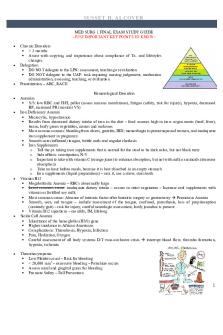
MED SURG 1 Final EXAM Study Guide
- 10 Pages
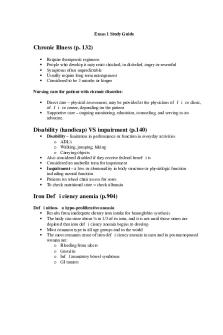
Exam 1 Study Guide - Med-Surg
- 26 Pages
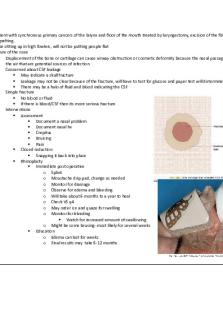
Med Surg II - Exam 2 Study Guide
- 57 Pages

Med Surg 2 Exam 3 Study Guide
- 22 Pages

Med surg exam 3 study guide
- 68 Pages

Med Surg Study guide Notes
- 66 Pages

Med Surg 2 Final Study Guide
- 25 Pages

Med Surg Exam 3
- 19 Pages
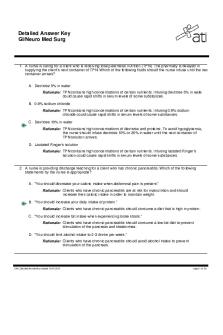
Ati gi med surg - Gi study guide
- 53 Pages
Popular Institutions
- Tinajero National High School - Annex
- Politeknik Caltex Riau
- Yokohama City University
- SGT University
- University of Al-Qadisiyah
- Divine Word College of Vigan
- Techniek College Rotterdam
- Universidade de Santiago
- Universiti Teknologi MARA Cawangan Johor Kampus Pasir Gudang
- Poltekkes Kemenkes Yogyakarta
- Baguio City National High School
- Colegio san marcos
- preparatoria uno
- Centro de Bachillerato Tecnológico Industrial y de Servicios No. 107
- Dalian Maritime University
- Quang Trung Secondary School
- Colegio Tecnológico en Informática
- Corporación Regional de Educación Superior
- Grupo CEDVA
- Dar Al Uloom University
- Centro de Estudios Preuniversitarios de la Universidad Nacional de Ingeniería
- 上智大学
- Aakash International School, Nuna Majara
- San Felipe Neri Catholic School
- Kang Chiao International School - New Taipei City
- Misamis Occidental National High School
- Institución Educativa Escuela Normal Juan Ladrilleros
- Kolehiyo ng Pantukan
- Batanes State College
- Instituto Continental
- Sekolah Menengah Kejuruan Kesehatan Kaltara (Tarakan)
- Colegio de La Inmaculada Concepcion - Cebu

